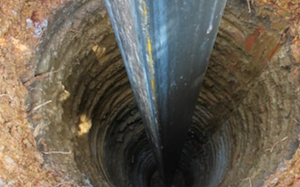California utilities commission approve underground natural gas storage increase at site of nation’s largest methane leak
LOS ANGELES (AP) — California regulators on Thursday approved a controversial proposal to greatly increase storage capacity at the site of the nation’s largest known methane leak, which sickened thousands of families and forced them from their Los Angeles homes in 2015.

The California Public Utilities Commission voted 5-0 to permit underground storage of up to 68.6 billion cubic feet of gas at the vast Aliso Canyon field on the northern edge of Los Angeles County as a way to guard against fuel price spikes.
That’s more than a 50% increase over the current cap at the Aliso Canyon Natural Gas Facility, which is slated to be closed in 2027. It’s also near the maximum capacity of 86 billion cubic feet but within safety standards set by another state agency.
The expanded storage was requested by Southern California Gas Co., which operates the facility, and was backed by the commission’s staff. SoCalGas and San Diego Gas & Electric Co. said it would be better to buy natural gas during the summer and fall months when it’s generally cheaper and store it for winter use.
The move “is a prudent step to advance our shared goal of maintaining energy reliability at just and reasonable rates,” SoCalGas spokesperson Chris Gilbride said in a statement.
The commission’s president, Alice Busching Reynolds, said the expansion was needed to keep gas bills affordable given the unpredictability of extreme weather events due in part to climate change, as well as the volatile wholesale natural gas market. She noted that California imports 90% of its natural gas from out of state.
She vowed that the commission will work toward weaning the region off the facility while the state transitions to cleaner energy.
“We will reduce our dependency on Aliso Canyon, but we also need to allow people, especially low income and vulnerable communities, to access affordable energy as we move to a new electrified economy,” she said before announcing her approval of the expansion.
The commission, which regulates and oversees gas, electric and other utilities, said the increase could save customers anywhere from $200 million to $450 million this winter.
The 2015 Aliso Canyon gas leak, which took four months to control, released more than 120,000 metric tons of methane and other gases into the atmosphere over communities in the San Fernando Valley.
Thousands of residents were forced to move out of their homes to escape a sulfurous stench and maladies including headaches, nausea and nose bleeds. SoCalGas and its parent company, Sempra Energy, agreed to pay up to $1.8 billion in settlements to more than 35,000 victims in 2021.
Earlier this month, the company reached another settlement with the utilities commission, agreeing to pay more than $70 million to the Aliso Canyon Recovery Account to address the impacts from the leak on air quality and public health.
Speakers at Thursday’s commission meeting were uniformly opposed to permitting more storage.
“My mind is just blown that we’re actually talking about this again,” said Jane Fowler of the Granada Hills neighborhood and co-founder of the Aliso Moms Alliance. “We’re trying to get off fossil fuels for our future, for everyone’s future. Why would we be going backward?”
The commissioners were all appointed by Democratic Gov. Gavin Newsom, who has endorsed a plan to shut down the facility by 2027.
The field, which stores gas in old wells, was at 50% capacity for years following the leak. But the commission started increasing its storage in 2020, saying it needed to ensure supplies of natural gas for the winter months. The volume is currently at 41.16 billion cubic feet.
Administrative Law Judge Zhen Zhang for the commission proposed allowing the increased storage capacity, noting that California and the West saw sharp spikes in the price of wholesale natural gas last winter that affected customers’ energy bills.
“On balance, as a matter of policy, it is prudent to take the conservative approach by protecting natural gas and electricity customers from reliability and economic impacts during the upcoming 2023-2024 winter,” the judge wrote.
Related News
From Archive

- DeLa Express seeks FERC approval for Permian-to-Louisiana gas pipeline project
- OSHA penalizes Houston contractor over safety violations resulting in worker's death
- Fiber infrastructure has no known expiration date, Fiber Broadband Association research concludes
- Nevada OSHA fines Elon Musk's Boring Company over safety violations in Vegas tunnel project
- Damage prevention and safety: Turning awareness into action
- Ditch Witch 1030
- Michigan lawmakers introduce bills to create septic codes throughout the state
- Indiana American Water to gain 8,000 water customers with Silver Creek Water acquisition
- Arkansas governor allocates $42 million for water infrastructure projects
- Federal judge finds Flint, Mich, in contempt over lead water pipe crisis



Comments